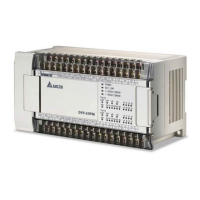9 Electrical CAM
DVP-PM Application Manual
9-64
(mm/pulses)
Winding shaft
(Master/Y
axis)
Length of single speed
positioning (pulses)
=N2 x B
Master=
= 100 x 3600 = 360000
Master
Max
(pulses)
=2 x N1 x B
Master
= 2 x 20 x 3600 = 144000
“2” indicates double layer winding
Settings
Coil shaft
(Slave/X axis)
Slave
max
(pulses)
=N1 x D/C
Slave
= 20 x 0.3 / (0.1/100)
=6000
9.6.2 E-CAM Application on Rotary Cut and Flying Saw Devices
The traditional material feeding and cutting applications apply go-and-stop pattern. The feeding control axis
moves the material for a fixed distance and the cutting control axis performs the cutting process. In this pattern,
feeding control axis repeats the move-and-stop actions while cutting control axis repeats cut-and-stop actions.
Therefore, a go-and-stop working pattern is formed. However, the production efficiency of the pattern is low due
to the deceleration and acceleration time generated in go-and-stop process. Aiming at this problem, most
current cutting applications apply continuous cutting patterns, such as rotary cut and flying saw, which have
some difference with each other on E-CAM data design. Flying saw operates in reciprocating movements while
rotary cut operates in the same direction. In addition, thick material cutting also works in the same direction as
rotary cut. The difference between think material cutting and rotary cut is the E-CAM curve variation in cutting
process. Unlike the constant proportion curve of rotary cut’s sync area, the E-CAM curve of thick material cutting
varies during the cutting process between the start and the end of cutting. The 3 E-CAM applications are
explained as below.
9.6.2.1 Rotary Cut
When the rotary cutter performs cutting action, the feeding conveyor does not slow down and stop. When the
cutter touches the material, the moving speed of cutter should be the same as that of the feeding conveyor. If
the cutter is slower than the conveyor, the material will be squeezed and piled; if the cutter is faster than the
conveyor, the material will be extended and damaged.
The operation and simple wiring of rotary cut is illustrated as below. Positions 1, 2, 3 and 4 respectively indicate
starting posiiton, middle position, end position and ready position of speed synchronization. When Master (Y
axis) executes, Slave (X axis) accelerates from position 4 to position 1, reaching the synchronizing speed. The
sync speed is maintained from position 1 to position 3. After position3, Slave decelerates and returns to position
4. The cycle repeats for continous rotary cut operation.

